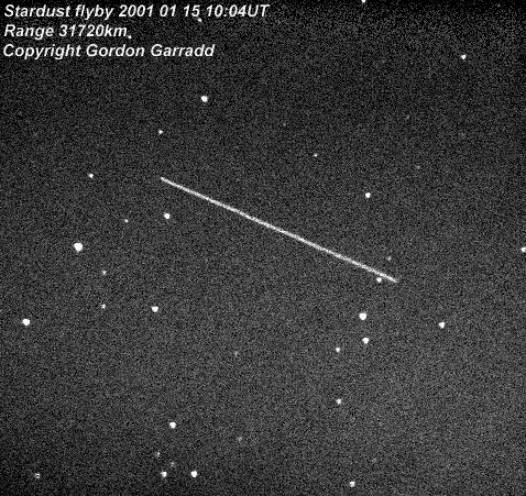Credit & Copyright: Gordon Garradd
Explanation:
Spacecraft on long interplanetary
voyages
often use the
planets themselves as gravitational "sling shots" to
boost them along their way.
Launched
in February of 1999 on a historic voyage to a comet,
the
Stardust spacecraft is no different.
On 15 January 2001 Stardust made its closest
approach
to planet Earth since launch,
coming within about 6,000 kilometers of the surface.
It used this
gravity
assist maneuver to increase its speed
and alter its trajectory
toward an encounter with
comet Wild 2,
which it should reach in 2004.
Shortly before its time of closest approach, astronomer
Gordon Garradd recorded
this
exposure of Stardust sailing
through the skies above Loomberah, Australia.
Nearby
and moving fast, the spacecraft appears as a streak
against a background of faint stars in the constellation
Cetus.
Stardust cruised within just 98,000 kilometers
of the Moon
about 15 hours later.
After
collecting dust from the tail of comet Wild 2,
Stardust's
voyage will continue -- as it returns
the samples to Earth in 2006.
1999 2000 2001 2002 2003 2004 2005 2006 2007 2008 2009 2010 2011 2012 2013 2014 2015 2016 2017 2018 2019 2020 2021 2022 2023 2024 2025 |
Yanvar' Fevral' Mart Aprel' Mai Iyun' Iyul' Avgust Sentyabr' Oktyabr' Noyabr' Dekabr' |
NASA Web Site Statements, Warnings, and Disclaimers
NASA Official: Jay Norris. Specific rights apply.
A service of: LHEA at NASA / GSFC
& Michigan Tech. U.
|
Publikacii s klyuchevymi slovami:
komety - comet - kosmicheskie apparaty - spacecraft - Proekt Stardust - Stardust project - zvezdnaya pyl'
Publikacii so slovami: komety - comet - kosmicheskie apparaty - spacecraft - Proekt Stardust - Stardust project - zvezdnaya pyl' | |
Sm. takzhe:
Vse publikacii na tu zhe temu >> | |
